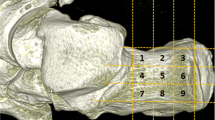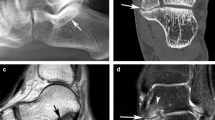Abstract
Background
A variant form of subtalar coalition isolated to the posterior sustentaculum has been previously described, though its prevalence is not known and its relationship to the middle facet has not been characterized.
Objective
To determine the prevalence and morphological alterations of isolated posteromedial subtalar coalitions.
Materials and methods
Computed tomography (CT) images of the foot or ankle performed from 2004 to 2012 were reviewed and 97 patients (mean age: 13.3+/-2.9 years; range: 9-19 years) with subtalar coalition were identified. In 41 (42%) of these, the condition was bilateral, yielding a total of 138 subtalar coalitions. In the 33 patients where CT demonstrated isolated posteromedial subtalar coalitions, multiplanar reformats along the long axis of the sustentaculum tali were generated, from which the anteroposterior dimensions of the sustentaculum tali and middle facet were measured. Posterior sustentaculum measurements defining the posterior extension of the sustentaculum beyond the middle facet were directly measured by two radiologists. Ratios of middle facet to posterior sustentaculum measurements were calculated. Thirty-three patients undergoing CT for ankle fracture served as controls.
Results
Ninety-seven of 138 coalitions (70.2%) affected the middle facet and 2/138 (1.4%) involved the posterior facet. There were 39 (28.2%) posteromedial subtalar coalitions in 33 patients. Mean AP measurements of the middle facet and posterior sustentaculum in patients with posteromedial subtalar coalitions were 12.6 mm and 18.2 mm, respectively, compared to 16.6 mm and 9.2 mm in controls (P<0.001). Mean middle facet/posterior sustenaculum (MF/PS) ratios were 0.74 for posteromedial subtalar coalitions vs. 1.92 for controls (P<0.001).
Conclusion
Posteromedial subtalar coalitions comprise more than one-quarter of subtalar coalitions, and are associated with an intact, but shorter, middle facet and longer sustentaculum tali. This observation may aid in accurate diagnosis and management of this relatively common disorder.








Similar content being viewed by others
References
Mosier KM, Asher M (1984) Tarsal coalitions and peroneal spastic flat foot. J Bone Joint Surg Am 66A:976–984
Harris RI (1965) Retrospect-peroneal spastic flat foot (rigid valgus foot). J Bone Joint Surg Am 47:1657–1667
Kernbach KJ (2010) Tarsal coalitions: etiology, diagnosis, imaging, and stigmata. Clin Podiatr Med Surg 27:105–117
Stormont DM, Peterson HA (1983) The relative incidence of tarsal coalition. Clin Orthop Relat Res 181:28–36
Linklater J, Hayter CL, Vu D et al (2009) Anatomy of the subtalar joint and imaging of talo-calcaneal coalition. Skeletal Radiol 38:437–449
Klein MA, Spreitzer AM (1993) MR imaging of the tarsal sinus and canal: normal anatomy, pathologic findings, and features of the sinus tarsi syndrome. Radiology 186:233–240
Chew F (2003) Developmental and congenital conditions. In: Musculoskeletal imaging. Lippincott Williams & Wilkins, Philadelphia, pp 432-433
Laor T (2008) Congenital malformations of bone. In: Slovis TL (ed) Caffey’s pediatric diagnostic imaging, 11th edn. Mosby, Philadelphia, pp 2602–2603
Cass AD, Camasta CA (2010) A review of tarsal coalition and pes planovalgus: clinical examination, diagnostic imaging, and surgical planning. J Foot Ankle Surg 49:274–293
Lim S, Lee HK, Bae S et al (2013) A radiological classification system for talocalcaneal coalition based on a multi-planar imaging study using CT and MRI. Insights Imaging 4:563–567
Harris RI, Beath T (1948) Etiology of peroneal spastic flat foot. J Bone Joint Surg (Br) 30:624–634
Lee MS, Harcke HT, Kumar SJ et al (1989) Subtalar joint coalition in children: new observations. Radiology 172:635–639
McNally EG (1999) Posteromedial subtalar coalition: imaging appearances in three cases. Skeletal Radiol 28:691–695
Yun SJ, Jin W, Kim GY et al (2015) A different type of talocalcaneal coalition with os sustentaculum: the continued necessity of revision of classification. AJR Am J Roentgenol 205:W612–W618
Rosanzky A, Varley E, Moor M et al (2010) A radiologic classification of talocalcaneal coalitions based on 3D reconstruction. J Child Orthop 4:129–135
Staser J, Karmazyn B, Lubicky J (2007) Radiographic diagnosis of posterior facet talocalcaneal coalition. Pediatr Radiol 37:79–81
Hyer CF, Lee T, Block AJ et al (2002) Evaluation of the anterior and middle talocalcaneal articular facets and the Evans osteotomy. J Foot Ankle Surg 41:389–393
Newman JS, Newberg AH (2000) Congenital tarsal coalition: multimodality evaluation with emphasis on CT and MR imaging. Radiographics 20:321–332
Emery KH, Bisset GS 3rd, Johnson ND et al (1998) Tarsal coalition: a blinded comparison of MRI and CT. Pediatr Radiol 28:612–616
Wechsler RJ, Schweitzer ME, Deely DM et al (1994) Tarsal coalition: depiction and characterization with CT and MR imaging. Radiology 193:447–452
Cahill DR (1965) The anatomy and function of the contents of the human tarsal sinus and canal. Anat Rec 153:1–17
Jotoku T, Kinoshita M, Okuda R et al (2006) Anatomy of ligamentous structures in the tarsal sinus and canal. Foot Ankle Int 27:533–538
DeLong ER, DeLong DM, Clarke-Pearson DL (1988) Comparing the areas under two or more correlated receiver operator characteristic curves: a non-parametric approach. Biometrics 44:837–845
Kumar SJ, Guille JT, Lee MS et al (1992) Osseous and non-osseous coalition of the middle facet of the talocalcaneal joint. J Bone Joint Surg Am 74:529–535
Author information
Authors and Affiliations
Corresponding author
Ethics declarations
Conflicts of interest
None
Rights and permissions
About this article
Cite this article
Bixby, S.D., Jarrett, D.Y., Johnston, P. et al. Posteromedial subtalar coalitions: prevalence and associated morphological alterations of the sustentaculum tali. Pediatr Radiol 46, 1142–1149 (2016). https://doi.org/10.1007/s00247-016-3584-0
Received:
Revised:
Accepted:
Published:
Issue Date:
DOI: https://doi.org/10.1007/s00247-016-3584-0




